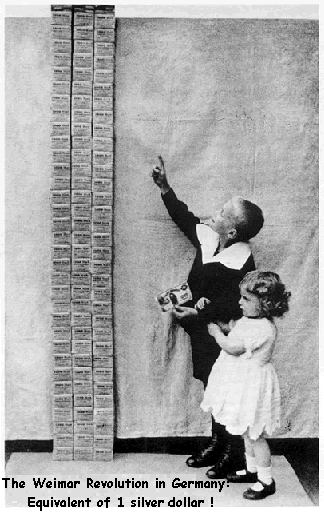UNDERSTANDING INFLATION AND DEFLATION
Posted on July 11, 2008 - Francis D. Schutte
- Francis D. Schutte
It more and more occurs to me that people have not the slightest idea of what Inflation and Deflation are and what the consequences are for the investor. Also, few understand the difference between Inflation and what is defined as Hyper-inflation.
The definitions of Inflation and Deflation will be skipped as these have been explained in detail earlier under Academics.
In economics, hyperinflation is inflation that is "out of control," a condition in which prices increase rapidly as a fiat paper currency loses its value. Formal definitions vary from a cumulative inflation rate over three years approaching 100% (Today, many goods exceed the 100%) to "inflation exceeding 50% a month." In informal usage the term is often applied to much lower rates. As a rule of thumb, normal inflation is reported per year, but hyperinflation is often reported for much shorter intervals, often per month.
Another definition of Hyperinflation is any inflation rate over 20% and/or any condition where prices rise faster than the Money Supply. This is another important reason why authorities in the USA have stopped publishing the M3 figures, why it is so hard to find correct figures for the EU and why all Inflation Indexes are cooked.
The definition used by most economists is "an inflationary cycle without any tendency toward equilibrium." A vicious circle is created in which more and more inflation is created with each iteration of the cycle. Although there is a great deal of debate about the root causes of hyperinflation, it becomes visible when there is an unchecked increase in the money supply or drastic debasement of coinage, and is often associated with wars (or their aftermath - Iraq, Afghanistan), economic depressions, and political or social upheavals. Because taxation and financing have become impossible, in the final stage, authorities monetize their debt.
The reason why it can be so hard to ‘understand’ we have (hyper)inflation is that in a (hyper)-inflationary cycle and certainly in the initial stage NOT ALL PRICES RISE. Some prices, by name of these of the HOCG will even tend to fall.
As explained by Von Mises, as a result of Fractional Reserve Banking, Fiat Money and inflation, at a certain point, the prices of HOCG (High order capital goods) tend to fall and those of LOCG (low order consumer goods) tend to rise. In other words, we have a (hyper)inflation cycle but we still see some prices fall. We have (hyper)inflation and deflation at the same time. Rather confusing.
The shift from HOCG to LOCG exists because of a misallocation of funds. In other words, funds that should have been used to improve the agriculture and to increase the energy supply, were misallocated to for example the Real Estate market, and were used in the dot.com and stock market bubbles. However, because of oversupply, at a certain point, the demand for HOCG dries up and as suppliers/manufactures scramble to sell the overstock, interest rates go up and prices of HOCG come down.
Meantime, no or little attention has been paid to the LOCG. No new investments nor research were made (because of the misallocation of funds there was no incentive), existing installations/plants became inefficient and outdated. Politicians did not understand the problem either and used the mass psychology to earn votes by not allowing the construction of Nuclear Power and Clean Coal plants, by making it difficult and even impossible to drill for more oil and to built new petrochemical refineries. No attention was given to the failing supply of LOCG. At a certain point, we see a growing disequilibrium between supply and demand (Peak oil and food commodities) and we end up having an inelastic supply (peak oil) and a rising or stable demand for the LOCG . Prices start rising at an abnormal rate. There is inflation and sometimes hyperinflation.
Important is to understand that this is the direct result of Fractional Reserve Banking and Fiat money creation by the Banks and Political authorities. In other words, they are at the very origin of the evil they are blaming the speculators for today.
A recession and depression starts and last until all of the misallocated funds have been recycled correctly into the LOCG. The longer the cleaning cycle is delayed by subsequent credit injections by Banks and Politicians (more fiat money, more misallocations and more inflation), the stronger and pain fuller the cleaning action and potential crash of the HOCG and the recession and depression.
If authorities really mean to stop inflation, they should stop Fractional Reserve Banking and the creation of Fiat Money.
| Price increase of LOCG y/y | 1 year | 3 years * |
| Steel | 40% to 70% | 150% |
| Chemicals | 25% | 75% |
| Shipping costs | 375% | |
| Crude oil | 43% | 129% |
| Ethanol | 21% | 63% |
| Heating oil | 44% | 132% |
| Natural gas | 77% | 231% |
| Unleaded gas | 40% | 120% |
| Corn | 60% | 180% |
| Soy beans | 26% | 78% |
| Aluminum | 35% | 105% |
| Copper | 26% | 78% |
| * extrapolated over 3 years | ||
| Price decrease of HOCG | ||
| Real Estate | -20% to -60% | |










